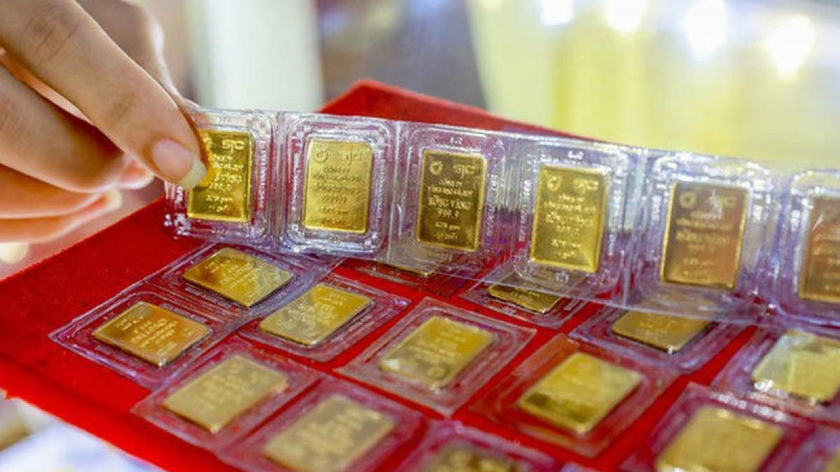Solutions to stabilize the Vietnam gold market
Vietnam gold prices have fluctuated dramatically in recent days. Many analysts believe that the State Bank of Vietnam should give special treatment shortly in order to stabilize the gold market.

Vietnam gold prices have been wildly fluctuating in recent days.
Many experts feel that distinguishing between the physical and non-physical gold markets is crucial for proper gold management orientation.
Gold Prices in Turmoil
Gold prices in Vietnam have been volatile in recent days. The price of SJC gold bars once topped VND 92 million per tael, about VND 20 million more than the converted international gold price.
Observing the local gold market over the years reveals that when gold prices reach a "fever," individuals become increasingly eager to buy. Many individuals have had to line to acquire gold in recent days, and others have even had to leave empty-handed when stores said they ran out of gold to sell.
Gold prices continue to "fever" due to a scarcity of domestic gold supply, since the State Bank of Vietnam (SBV) has not allowed any firm to import raw gold for jewelry production for more than ten years. Furthermore, as of May 14th, only 14,900 SJC gold bars (more than 550 kilos) have been provided to the market from a total of 33,600 SJC gold bars offered.
According to the World Gold Council (WGC), Vietnam's gold consumption demand has remained relatively strong in recent years. In 2022 and 2023, Vietnam's gold consumption demand was 59.1 tons and 55.5 tons, respectively. Meanwhile, domestic gold mining produces only approximately 1.5-2 tons each year. Thus, if the SBV solely provides gold through auctions, it will be unable to balance existing gold supply and demand.
Auctions Are Like "Salt in the Ocean"
Many gold auctions have failed owing to insufficient restrictions regarding gold bar auctions. Dr. Le Xuan Nghia, a financial and banking specialist, believes that auction participants ultimately decide on the price and quantity. However, it is illogical for the SBV, as the vendor, to decide on both pricing and quantity.
The SBV's gold bar auctions aim to enhance the supply of gold in the market, hence reducing the difference between SJC gold bar prices and converted worldwide gold prices. However, it is clear that this aim has virtually failed.
In actuality, rising gold prices have a variety of effects rather than a large impact on the macroeconomy. However, if the SBV continues to import raw gold in order to make gold bars for auction, the exchange rate would be put under more pressure. This is because importing raw gold requires a significant quantity of foreign currency, and Vietnam's foreign exchange reserves are limit ed.

The IMF anticipated that Vietnam's foreign exchange reserves would be $98.7 billion by the end of 2023, which is equivalent to slightly over three months of imports. As a result, analysts believe that foreign exchange reserves should only be utilized to preserve exchange rate stability and fulfill the country's payment needs in economic operations, rather than being used excessively to purchase gold in order to create gold bars for sale.
As a result, the SJC gold bar auctions are ineffectual at bringing SJC gold bar values closer to converted international gold prices, as the SBV aims for. In fact, if the SBV continues to set high auction prices, SJC gold bar prices will grow even more than converted worldwide gold prices.
What Solutions Are Needed?
While gold bar auctions remain ineffectual, the SBV should shortly submit a proposal to the government to eliminate the gold bar monopoly and allow select eligible firms to import raw gold for manufacture, therefore contributing to the cooling of gold prices. However, this option would put pressure on the exchange rate since businesses will need to accumulate foreign cash to import gold. To achieve harmonious aims, the SBV must strike a balance.
In the long run, it is vital to clearly distinguish between the physical gold market and the non-physical gold market, rather than putting all of the burden on the physical gold market as it currently is. The physical gold market should meet the demand for gold for storage, jewelry manufacturing, and export.
According to many experts, in order to develop the jewelry gold industry into a key economic sector for the country, the government must soon submit to the National Assembly a proposal to remove jewelry gold from the list of conditional business lines under the Investment Law 2020, as jewelry gold is an ordinary commodity. Furthermore, the Ministry of Finance should shortly present a proposal to the government to alter the gold export tax rate in order to boost jewelry gold exports and regenerate the foreign currency used to import raw gold.
It is worth noting that between 2016 and 2020, when the export tax on gold was 0%, several businesses exported billions of dollars worth of jewelry gold, with the DOJI Group shipping 2.5 billion USD. However, since the government imposed a single export tax rate of 2% on gold goods, businesses have been unable to export.
For the non-physical gold market, the SBV must shortly apply to the government to create a national gold exchange. The gold exchange will fulfill the financial investment need for gold. "Setting up a gold exchange is critical. However, gold is a unique commodity, therefore the management strategy must be carefully studied," said Prof. Dr. Hoang Van Cuong, a National Assembly representative.
Previously, spontaneous gold trading floors with no legal passageways generated market volatility and other consequences. Now that the gold exchange operates inside tight legal boundaries, it will assist to narrow the difference between local and international gold prices, maintain transparency in all gold transactions, allow the government to collect taxes, and push back unlawful gold trading floors.
"A gold exchange will significantly reduce the demand for physical gold, avoid spending too much foreign currency on importing raw gold, and ease exchange rate pressure," said an expert, adding that many countries, including China, have successfully implemented gold exchanges to manage the gold market.








